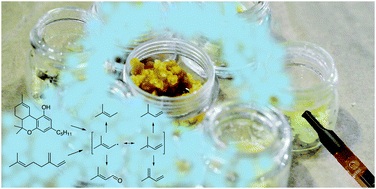The influence of terpenes on the release of volatile organic compounds and active ingredients to cannabis vaping aerosols†
Abstract
Dabbing and vaping cannabis extracts have gained large popularity in the United States as alternatives to cannabis smoking, but diversity in both available products and consumption habits make it difficult to assess consumer exposure to psychoactive ingredients and potentially harmful components. This work studies the how relative ratios of the two primary components of cannabis extracts, Δ9-tetrahydrocannabinol (THC) and terpenes, affect dosage of these and exposure to harmful or potentially harmful components (HPHCs). THC contains a monoterpene moiety and has been previously shown to emit similar volatile degradation products to terpenes when vaporized. Herein, the major thermal degradation mechanisms for THC and β-myrcene are elucidated via analysis of their aerosol gas phase products using automated thermal desorption-gas chromatography-mass spectrometry with the aid of isotopic labelling and chemical mechanism modelling. Four abundant products – isoprene, 2-methyl-2-butene, 3-methylcrotonaldehyde, and 3-methyl-1-butene – are shown to derive from a common radical intermediate for both THC and β-myrcene and these products comprise 18–30% of the aerosol gas phase. The relative levels of these four products are highly correlated with applied power to the e-cigarette, which indicates formation of these products is temperature dependent. Vaping THC–β-myrcene mixtures with increasing % mass of β-myrcene is correlated with less degradation of the starting material and a product distribution suggestive of a lower aerosolization temperature. By contrast, dabbing THC–β-myrcene mixtures with increasing % mass of β-myrcene is associated with higher levels of HPHCs, and isotopic labelling showed this is due to increased reactivity of β-myrcene relative to THC.

- This article is part of the themed collection: 2021 RSC Advances HOT Article Collection


 Please wait while we load your content...
Please wait while we load your content...